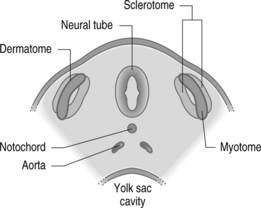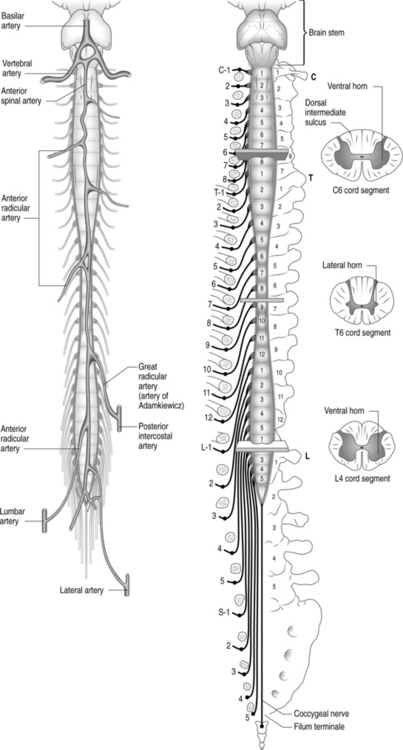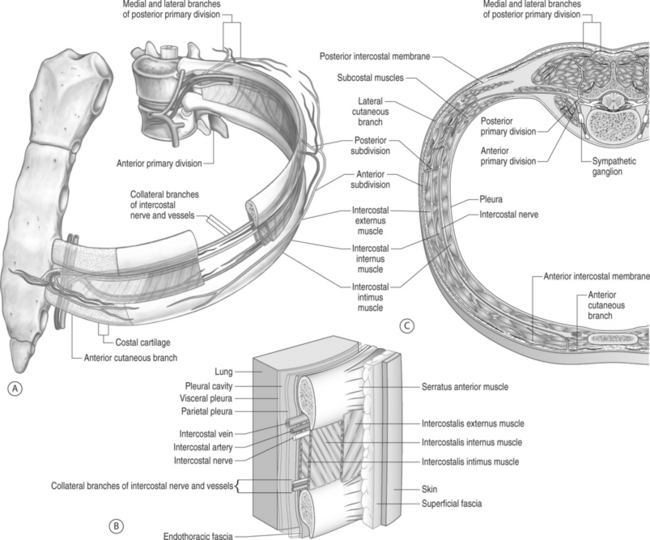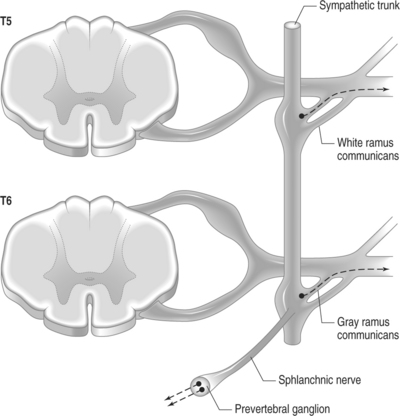CHAPTER 71 Developmental and Functional Anatomy of the Thoracic Spine
The thoracic spine has long been treated as the ugly stepsister of the cervical and lumbar spine. It has received little research or review, mostly because thoracic spinal pain syndromes are relatively uncommon or underdiagnosed. The thoracic spine covers more segments than the cervical and lumbar spine, thus making exhaustive research difficult. In addition, the backdrop of rib articulations to the 12 thoracic spinal segments provides inherent stability to this region. Thus, the thoracic spine pain generators are not as susceptible to mechanical forces. Guidelines for the treatment of thoracic spinal pain are nonexistent and are ripe for research.1 However, to develop reasonable guidelines in a field of spine medicine without much research, a thorough understanding of the anatomy and biomechanics of the thoracic spine is needed.
DEVELOPMENTAL ANATOMY
Neuralization
Neural tube development begins with the formation of the notochord around day 20 of embryogenesis. The neural tube will eventually develop into the spinal cord and brain. The surrounding mesoderm condenses to form somites.2 Somite differentiation in the early part of fetal development separates cells into the dermatome, myotome, and sclerotome cells (Fig. 71.1).
Sclerotome
The vertebrae and associated ligaments are formed by the development of sclerotome cells into a segmental centrum which forms cartilage and then the bony vertebral body.2 Primary and secondary ossification centers provide growth areas to turn cartilage into bone. The secondary ossification centers in the annular epiphysis (apophyseal rings) remain open through adolescence. Scheurmann disease or kyphosis may be caused by an insult to these secondary ossification centers. Eventually, Schmorl’s nodes can develop in these individuals with Scheurmann disease such that disc material herniates through the insulted vertebral endplate. Two other posterior primary ossification centers come together to form the neural arch. Rarely, particularly in the setting of poor folate intake, neural arch and tube defects (e.g. spina bifida and hemivertebrae) may arise.
Neural tube
The inferior portion of the neural tube differentiates into ependymal (central), mantle (neurons and glia), and marginal layers (axons of tract cells).2 These eventually form the future spinal cord. The neural crest develops into neurons of the peripheral nervous system.
Postural curves
Developmentally, the in utero spine is flexed so that the fetal position is achieved. However, with age and weight bearing, the primary curve of the spine gives way to secondary curves in the cervical and lumbar spine (i.e. lordosis). The thoracic spine remains with the primary curve and, thus, in kyphosis.3 Normal thoracic kyphosis allows for the anterior height of the thoracic vertebral body to be 1.5–2 cm shorter than the posterior height.3 Scoliosis is common in the thoracic spine region. Some have theorized that idiopathic scoliosis may be partly an embryogenesis problem with inadequate development of the junction between the centrum and the neural arch (i.e. neurocentral synchondrosis).
NEURAL ANATOMY
Thoracic spine pain generators
There have been no comprehensive studies on the innervation schemes of the thoracic spine other than some published descriptions of the dorsal rami of the thoracic spine.4 Innervation schemes must be understood so that pain generators of the thoracic spine can be precisely identified. To date, the thoracic zygapophyseal joints, intervertebral disc, costovertebral joints, and posterior thoracic muscles have been proven to have nerve supply.4 However, other thoracic structures are also likely to be sources of pain (e.g. costotransverse joint, vertebral body) (Table 71.1) In addition, the thoracic spine houses much of the autonomic nervous system of the human body, a well-known modulator of pain syndromes. Ligaments about the thoracic spine, such as the interspinous ligament and posterior longitudinal ligament, may also cause thoracic spine pain.5
Table 71.1 Thoracic Spine Pain Generators
| Thoracic zygapophyseal joints |
| Thoracic intervertebral disc |
| Costovertebral joints (e.g. synovitis from ankylosing spondylitis) |
| Posterior thoracic muscles (e.g. trigger points) |
| Costotransverse joint |
| Vertebral body (e.g. compression fractures) |
| Dura mater |
| Epidural blood vessels |
| Posterior longitudinal ligament |
| Sympathetic trunk |
Types of thoracic pain
Thoracic spine pain conditions can be differentiated by the classifying pain into superficial and deep pain (Table 71.2).6 Superficial pain is sharp pain that is fairly localized and occurs from irritation of the skin or mucosa. The so-called first pain is modulated by the A-delta fibers, followed by second pain modulated by C-fibers. Deep somatic pain may occur from irritation of structures such as periosteum, ligaments, joints, tendons, fascia, and muscles (in order of lower to higher pain threshold). Somatic structures have been shown, by Kellgren’s classic studies, to refer pain distal to the site of irritation.5 On the other hand, radicular pain is fairly precise, shooting, neuropathic pain that is along a two-inch band.7 Many cases of thoracic somatic referred pain are misdiagnosed as thoracic radicular pain. It must be remembered that thoracic disc herniations as causes of thoracic radicular pain are rare. Thoracic somatic referred pain is much more common than thoracic radicular pain.
Table 71.2 Types of Pain: Somatic vs. Autonomic Nervous System
| Superficial cutaneous pain |
| Somatic pain |
| Somatic localized pain |
| Somatic referred pain |
| Radicular pain |
| Visceral pain |
| True or localized visceral pain |
| Visceral referred pain |
| Localized parietal pain |
| Referred parietal pain |
Thoracic spinal cord and its primary divisions
Spinal cord
The spinal cord is housed within the thoracic vertebral canal, which has a relatively small diameter when compared to the cervical and lumbar canal (Fig. 71.2). The lower thoracic vertebral canal and spinal cord are wider to allow for the lumbar segment of the spinal cord. In addition, the vertebral column grows at a faster rate than the spinal cord. Consequently, the newborn spinal cord ends by the L3 vertebral, whereas the adult spinal cord ends between T12 and L2 vertebral bodies.2 Overall, the thoracic spinal cord is smaller in size and has less gray matter relative to the cervical and lumbar spinal cord. There is less relative room in the thoracic vertebral canal and sparse cord vascular supply; thus, the thoracic spinal cord is a precarious area for injury. For those reasons, posterior thoracic decompression (particularly laminectomies) carries a greater relative risk of neural injury.8 In addition, the thoracic spinal cord has an enlargement of the lateral horn due to the incorporation of cell bodies of the preganglionic fibers of the sympathetic nervous system.
The spinal cord receives its vascular supply via the anterior spinal artery (ventral two-thirds of the cord) and a pair of posterior spinal arteries (dorsal one-third of the cord). The anterior spinal artery in the thoracic spine is feed by 4–5 radicular arteries. The largest of these radicular arteries is the great radicular artery of Adamkiewicz, which usually courses with a lower thoracic root or upper lumbar root (see Fig. 71.2). It will give vascular supply to the lumbosacral spinal cord segments. The anatomic course and supply of this great radicular artery has become clinically important for spinal injectionists. Inadvertent injection of particulate matter (steroid) into the greater radicular artery while performing a thoracolumbar transforaminal epidural steroid injection may cause paraplegia.9 Other invasive procedures such as lumbar sympathectomy and aortic surgery, or a dissecting aneurysm, may also interrupt supply to the greater radicular artery.2
In addition, the venous plexus about the thoracic spine has been implicated with metastatic cancer. In fact, the thoracic region is the most common location for metastatic spinal spread of many cancers.10
Branches of the thoracic spinal cord
The thoracic spinal cord provides the afferent and efferent contributions to the thoracic dorsal and ventral rootlets, respectively (Fig. 71.3). The rootlets come together to form ventral and dorsal roots. Within the intervertebral foramen, the roots form the short spinal nerve. As the spinal nerve exits the foramen, it enters the thoracic paravertebral space. Within this space, various branches are formed. The large anterior (ventral rami) and posterior (dorsal rami) primary divisions are created and housed within this space. Just before dividing into the rami, the sinuvertebral nerve is formed and returns medially through the intervertebral foramen. Also before the primary divisions are formed, the white and gray rami communicantes branches to the sympathetic trunk (Fig. 71.4). A thoracic paravertebral block will anesthetize all of the above branches.11
The thick anterior primary division is referred to as the ventral rami as well as the segmental nerve. The first 11 thoracic segmental nerves are named the intercostal nerves while the twelfth segmental nerve is named the subcostal nerve. Notably, the anterior primary division of T1 contributes to the brachial plexus. The second and third intercostal nerves also form the intercostobrachial nerve, which provides cutaneous innervation to the axilla and upper medial arm. The intercostobrachial nerve may be injured during axillary surgery and dissection. Thoracotomy incisions may famously cause injury to other levels of intercostal nerves. In fact, up to 61% of individuals may have a degree of post-thoracotomy pain one year after surgery.12
Stay updated, free articles. Join our Telegram channel

Full access? Get Clinical Tree












